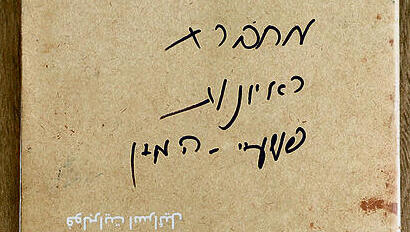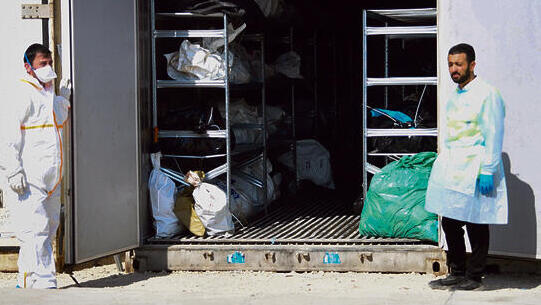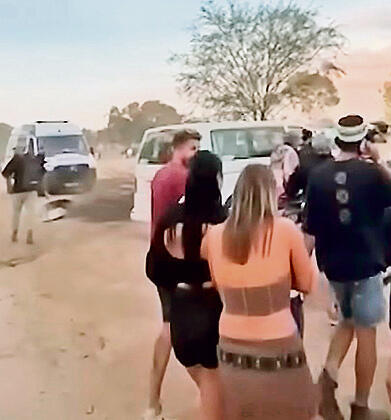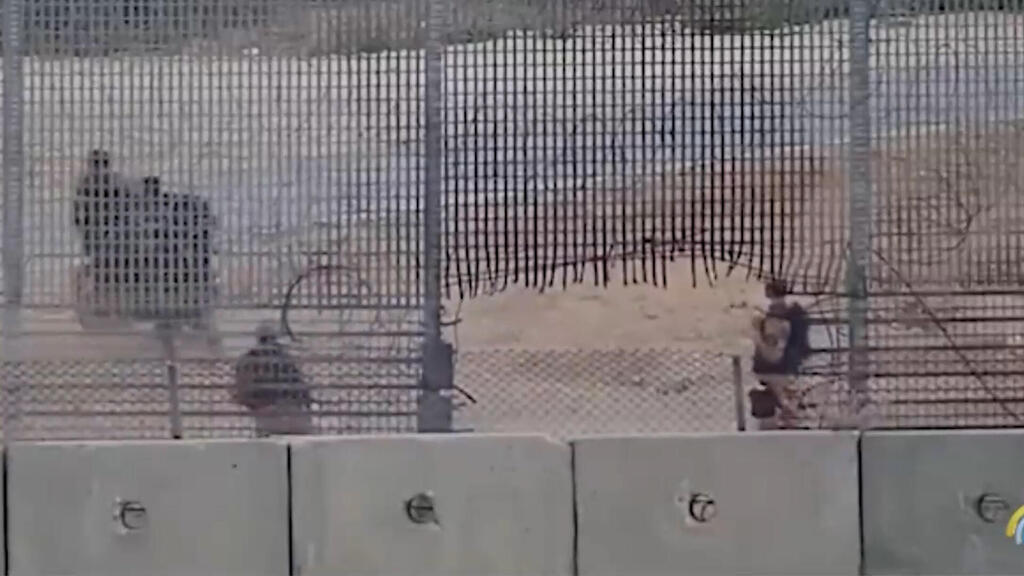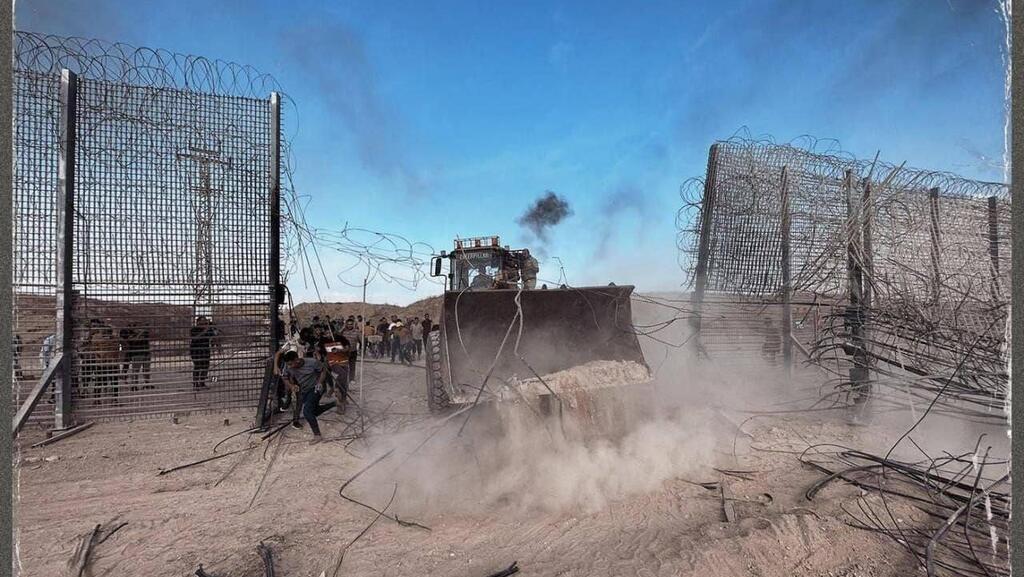Getting your Trinity Audio player ready...
Warning: This article contains content some readers may find disturbing
In the chaos at the IDF's Shura base on the days following the October 7 massacre, bodies of the murdered – soldiers, civilians and the occasional body that, after examination, turned out to be that of an abominable Nukhba terrorist, were piling up.
On one body alongside grenades, they found an open packet of condoms. “I read about this in the newspaper. It was part of a journal kept by a guy from Shura,” says leading Israeli lawyer, Prof. Yifat Bitton. “Our investigator contacted him and asked, ‘Tell me, did you report this to anyone?’ He said, ‘No. We had to deal with neutralizing the grenades. Why should I be dealing with condoms?’”
What might have been regarded on the ground as a rather marginal detail, for Prof. Bitton leading the struggle for recognition of Hamas’s sexual offenses, it was a warning sign. “For me, a terrorist with condoms indicates sexual offense. Maybe the packet of condoms was on him because he’d had consensual sex just before that, and the box had simply remained in his pocket.
"However as, in the wave of terrorist incursion incidents, we have no way of verifying this, and as we know that when armed men are in an environment where women are helpless, there’s a very high risk of sexual harm, these condoms may attest to sexual assault. If Hamas can, they’re welcome to prove otherwise. Until October 7, we hadn’t seen sexual assault as part of organized Hamas operations. This perception, however, needs to change.”
What does this story prove in terms of our investigations? That condoms are marginal to grenades?
“Not just marginal. It’s about seeing an outright indication right before your eyes, and erasing it from your mind. Not just because it’s not important.
"Yes, some people thought it was less important - like the senior Division of Identification and Forensic Science (DIFS) official who told me, ‘Listen, when I have the worst crime of all, murder, I don’t have to, and can’t, deal with this too.' But what they were looking at was sexual offense. Conditions also play a role: under any other circumstances, I’d examine the body in great detail, but I had 500 more bodies waiting in line.”
The mass of bodies meant you couldn’t tell the whole story.
“Yes. Everyone in the Hell that was Shura had a very specific task in identifying the bodies. They remained within the area and didn’t leave it. Either their eyes didn’t look over the entire body, or they did, and decided that they couldn’t really see it and couldn’t deal with it. Psychologists we interviewed told us that this is how it works – so as to protect the workers’ mental health from permanent damage. But this, apparently minor, story is a new way of looking at what happened here.”
'The dead are dead'
December 2023, a few months prior to that conversation, Bitton gave a speech at a conference she had initiated at the UN to promote world awareness of the horrific massacre’s incorporation of systematic gender-based violence. On returning home to Herzliya, however, she felt something wasn’t right. Something in the way the story was framed was distorting the big picture.
"A lieutenant colonel told me that he saw a woman tied to a pole, naked from the hips up. When I asked him what he did, he told me that he took her off the pole and completely covered her up."
“I revisited my speech’s opening sentence in which I said that nothing in my 20 years of representing victims of sexual offenses and researching the issue, had prepared me for this moment. I asked myself why I’d opted for this sentence. Why had nothing prepared me for this? After all, it’s no surprise that women are harmed on the battlefield. Why weren’t we prepared for this moment? I felt I knew only parts of what had happened. The entirety of what happened, however, was unprecedented and so demanded new decoding tools.
“We’re trying to use existing tools to understand something that hasn’t happened in the past. This is severely detrimental to our professional ability to prove what happened and explain why the evidence is so sparse relative to the scope of attacks. I realized it would be best to listen to people who were on the ground at the time, and through them, identify the true scope of sexual offenses on October 7.”
This realization led Bitton, President of Achva Academic College and head of Israel's Public Colleges Association, to an almost year-long quest resulting in an extremely comprehensive, in-depth report on October 7 sexual offenses. Alongside attorneys Vardit Avitan and Shir Burka and lawyer, Hodaya Shaked, she questioned and interviewed dozens of people from the field who saw the worst things a person could imagine.
This culminated into 80 pages in Hebrew, translating into 100 English pages, to serve Israel - not just in Hasbara terms, but also for international legal purposes. In their own personal time, and modestly funded by two foundations, the researchers set out with a clear mission.
“I asked myself, why this had gotten me so much. Why couldn’t I just deal with the other horrors that occurred there? I eventually realized that the situation I was now seeing, is one so often exposed when it comes to assaults - mainly against women – and that are sidelined. This isn’t very different from what we know about sexual violence in general. It needs working on, pushing, and explaining why it matters.
”The last thing I wanted was for the sexual offenses to be used as yet one more tool with which to goad the enemy. I was looking for a way to forge recognition for the victims. I was looking to find out how, knowing what we do about these incidents, we could set up dedicated treatment and investigation structures. This was my prime motive. And no one really wanted to do it.”
Did exposure to these materials affect you personally?
“The material was, obviously, very difficult. I am sadly, however, very experienced when it comes to the horrors of sexual offenses. Although it was unprecedented in terms of its scope and malevolence, I must stress that as soon as the project was about means for identifying and gathering evidence, that’s what we focused on.
"It’s also been very hard to prove the degree to which the interviewees were repressing what they’d seen or felt or were experiencing secondary trauma - that arose from the interviews. Some felt guilty, and it was important for me to explain to them that, considering the shock and chaos of what happened to us, there was nothing to feel guilty about.”
The report - whose findings were forwarded to officials at Israel’s National Security Council (NSC), terrorism specialists and the authorities at the United Nations Security Council responsible for dealing with sexual violence - reveals obstacles faced by various systems, that have prevented widescale documentation of the scale of the sexual assaults.
These obstacles are expressed by “first respondents,” professionals who, on October 7, encountered what we couldn’t have imagined in our worst nightmares. These include Zaka, police and Border Police, personnel as well as doctors at Camp Shura.
This failure touched on not only gathering evidence, but also the preliminary inquiry. It turns out that Israeli combatants in the massacre areas weren’t asked questions about sexual offenses. A senior police officer says in the report that this was sometimes a conscious decision, “so as to keep soldiers’ spirits robust, as they were returning to the battlefield.”
Another senior ranking Border Police officer told the investigator that she saw, “Loads of bras and underwear strewn around the party ground.” Bitton says, “She hadn’t told anyone before, as she wasn’t asked questions about indications, but rather about sexual offenses.
"If you ask, ‘Did you see sexual assaults,’ the answer would be no. But if you were to ask, ‘Did you see anything relating to women that looked odd to you,’ she’d say, ‘Actually yes.’ For me, this constitutes an indication of sexual offenses. That same officer did not photograph what he saw, and also instructed her subordinates not to photograph them either.”
Why?
“Because they were told, ‘We need to focus on the people who are alive. The dead are dead.' I heard this cited by both soldiers and psychologists. ‘This is what matters,' ‘This is what’s relevant.' These are the quotes. We’re now talking about an accumulation of almost 500 pieces of digital evidence.
"I remember two burned bodies whose legs were spread. In real time, we wanted to identify the bodies, not find out what had happened to them."
"In the videos, you don’t have to look for gang rape. You need to look for pictures of underwear on the ground. Understanding that we have to ask about indications, rather than the sexual offenses themselves, is groundbreaking.”
Many interviewed said that they didn’t forward the evidence they had photographed on their personal phones. “For example, pictures including very serious indications of sexual offenses, not passed on for fear of violating the victim’s privacy,” says Bitton. A senior Zaka official, who was present at the massacre scene, said he had a whole gallery of pictures he’d taken on his phone that he didn’t know what to do with.”
“A lieutenant colonel told me that he saw a woman tied to a pole, naked from the hips up. When I asked him what he did, he told me that he took her off the pole and completely covered her up. ‘It was important for me to put an end to her denegation, and certainly not document her in this horrific condition.' I understand the compassion by which he was guided, but that shouldn’t negate the importance of documentation, as long as there are clear and ethical guidelines as to how to do it.”
Hodaya Shaked, who collaborated on the report alongside Prof. Bitton, says, “One interviewee told me that, while surveying and clearing the bodies, he found a used condom on a bed in a house in the Gaza Periphery. He didn’t think to report it, and only thought about it differently when we talked about it.”
From these examples, we learn of the lack of readiness for terrorism that incorporates sexual violence - not just in the field, but afterward too, at Camp Shura. “Naked, or partially naked, bodies were showing up at Shura, and no one documented it,” says Bitton. “At Shura, they photographed operational injury. They didn’t, for example, photograph bruising adjacent to sexual organs.”
Coining a term: Sexual terror attack
Dr. Naama Samet, oral and maxillofacial surgery specialist, who has been volunteering with the IDF’s victims’ identification unit for the past 15 years, encountered this in the six weeks she spent identifying hundreds of bodies at Shura. She supports Prof. Bitton and her investigation team’s grim conclusions.
“The thought of sexual assault didn’t cross our minds,” she says. “We just opened up the top part of the body bags. On the second or third day, a Zaka guy rolled in a body in a cart. Helping him bring it in, I said, ‘There’s something strange here.' I thought there was another body inside. We then removed the body bag and saw that the pelvis was very clearly broken. This is how we understood that sexual assaults had occurred.”
Did it change the rest of the examinations?
“No. There wasn’t time for that. At some stage, you close up, just to get through. I remember two burned bodies whose legs were spread. In real-time, we wanted to identify the bodies, not find out what had happened to them. That was a mistake, but it would have taken months had we acted otherwise. There were horrific stories there.”
Bitton continues, “We suddenly realized that burning the houses and bodies or shooting the sexual organs was, in part, means to conceal the sexual assaults. Pramila Patten (United Nations Special Representative on Sexual Violence in Conflict, who came to Israel in January and then compiled a report concluding that sexual assaults by Hamas had indeed occurred), confirmed there had many gunshots at sexual organs, mainly but not only, of women.”
“At first, we viewed it as some kind of sexual obsession of theirs or efforts to eliminate sexuality. I now tell myself that this, in and of itself, constitutes sexual assault and that I can perhaps use this as an indication of covering up acute sexual assaults.”
In hindsight, we understand that assaults were on a greater scale, that so much evidence has been buried.
“Definitely. We’re proving that very clearly.”
Legal research and security expert Capt. (res.) Att. Shir Burka, who has been serving as war room commander at the Gaza Division for over a decade, was called on the afternoon of October 7 to the Northern Brigade’s improvised war room in the south of the country.
“As a war room officer, I experienced first-hand the tremendous chaos on the ground in the first days after the attack. Our priorities were clear: protecting human life, evacuating the dead and wounded, and preparing for an attack. At no stage were we briefed about sexual offenses.”
“With my background representing victims of sexual assault, as our work on the report progressed, I saw evermore gaps in the evidence and I could only scream out against the omission and the possibility that so many forces on the ground could have contributed toward identifying and documenting sexual offenses. But hindsight‘s 20/20. Had there been any awareness of it, things would have certainly looked different.”
Bitton: “Visiting one of the Gaza Periphery communities, I asked a local man to show me where the horrors had taken place. I wanted to be there, to smell it, hear the silent voices of the people I’m trying to make heard. As he was talking, I realized that he was, inadvertently, showing me a strong, horrific indication of the acute sexual abuse of two women.
"Realizing this, and not wanting to upset him, I asked him questions around the subject. With my tools, I continued the investigation in the house, went back to my interviewees, reconfirmed that what I had heard was correct, and learned that I was correct in my assessment. Talking to a police representative, I found that the police didn’t know about it.”
What did he say constituted an indication?
“He said that something just didn’t hang together about the house we were in. It was clear that what happened here, wasn’t what he had thought, and that he had no explanation as to what had happened, and that was telling himself the same story everyone probably tells themselves: They see an indication, but don’t regard it as demonstrating a high chance of sexual assault.”
Didn’t that put you in the position of police investigator?
“Definitely not. I’m not here to replace the police. We always forwarded new stories or evidence to which we were exposed. That’s not my role, and shouldn’t be anyone else’s role. That’s the state’s role.”
"It’s critical the state should adopt this report, the bodies mentioned in it read it, understand what’s missing in their work, and make corrections accordingly."
In their report, Bitton and her partners present new perceptions. Firstly: the obstacles faced in collecting and documenting evidence of sexual offenses, are rooted in this being a totally different kind of attack. And secondly: it may well happen again.
Let’s start with the first. The investigators called the October 7 terrorist attack an “incursive incident.” Bitton says, “This short-term attack on the land of a sovereign Westen state is a world-first. It’s an incursive terrorist incident in that they were invaders, they wandered around in the field, caused destruction, and left.
"Sexual offenses in Ukraine, for example, were part of an ongoing war. This is in no way similar to an incursive incident whose main purpose was killing as many people as possible, in which the victims were killed systematically.”
Prof. Boaz Ganor, President of Reichman University and the founder of the International Institute for Counter-Terrorism (ICT), who ranks among the world’s top terrorism experts, reiterates this. “I don’t remember any similar incident in modern times. Perhaps, the Boko Haram attack in Nigeria where they kidnapped girls from school, hurt them, and sold them as concubines. We also saw ISIS do this to the Yazidi women.”
8 View gallery


Hamas terrorists infiltrating Israel on October 7
(Photo: Qassam Bridges media office/Handout via REUTERS)
Ganor addresses another terrifying report conclusion regarding the likelihood of a second such attack in the wider world. “In the history of modern terrorism, attacks carried out against the State of Israel, serve as a model copied by other organizations. In the 1960s, Israel ranked among the countries suffering most from airplane hijackings.
"We then saw it spread to other places, among other things, because Israel found ways to better address the issue. It was similar with suicide attacks that started here in 1992, and a decade later became familiar in Europe and the U.S. So, one must ask whether October 7 could serve as a model to be imitated in other Western countries.”
And what do you think?
“I think that an incursive terrorist attack like this can be imitated in places adjacent to territories over which the state has no effective control. If we look at Europe and the US, it doesn’t seem likely. However, we’re beginning to see areas over which the state has little, or no, effective control.
"Even in Europe, there are areas - like Brussels’ Molenbeek neighborhood, that the police and law enforcement authorities seldom, or fear to, go. Paris also has quarters like this. I believe we’ll probably see incursive terrorist attacks from such neighborhoods in Europe, similar in essence to the October 7 incursion attack.”
What do you feel this report contributes?
“It has two important aspects. Firstly: casting light on the horrific sexual offenses committed on October 7. Secondly: addressing the challenges faced by first respondents arriving at the scene of such a huge incursive terrorist attack, who are busy dealing with other issues like saving lives, fighting, and obviously not collecting the facts required to prove sexual offenses.
"In the wider world, some people are still saying that these claims are some kind of Israeli scam. This report says that, alongside other activity, it’s also important to have clear guidelines and operating methods to gather the evidence, not only for indictment purposes, but also to show the world.”
Challenges in making sense of evidence
“It was important for me to investigate how these various structures operated,” says Bitton. “Was there any kind of awareness, and what did they do? The answer is that people on the ground were not aware of it, and so did almost nothing. I’m not criticizing them. It’s Hell. Guilt must rest on Hamas who caused the chaos.”
The report, however, presents the state’s failures.
“We have to view them as shortcomings - the inability to imagine. I call it, ‘When the unimaginable becomes a reality.' It’s a nightmare. It no use judging in hindsight.”
Att. Vardit Avidan, Bitton's team’s sexual protection expert, supports this. “It was important for us to cast blame on Hamas. Yes, a response could have been better in some cases, but if we prepare correctly, we’ll be able to get better evidence in the future.”
Israelis fleeing terrorists on October 7
How?
Bitton: “I learned that the DIFS is the only organization that can identify dead civilians in Israel. This is the only body in the country authorized to conduct this procedure. The identification process involves taking fingerprints, dental photos and conducting DNA tests. This means that Israel’s number one investigation body was conducting an activity that’s very easy to train people on the ground to do.”
“The sheer workload meant that that it was a month before DIFS got into the field, by which time the crime scenes had been corrupted, damaged or destroyed. This was the case for the Nahal Oz outpost where dozens of male and female soldiers - and the highest number of women - were murdered.
"The army’s surveillance unit, with its forensic documentation expertise (which it may utilize in the future) didn’t manage to get there at all. Instead, Zaka evacuated the bodies from the scene to another kibbutz. One interviewee told me ‘By that stage, you couldn’t understand who was who.'”
“These are evidentiary problems from Hell. There was also a lack of collaboration between the various respondents who were working under fire and the fear of being kidnapped. And yet, when we finally come to talk about sexual offenses, they have the tenacity to ask us, ‘Where’s your evidence?.'”
Has anything changed in procedures since then?
“The answer is not yet. That’s why I believe it’s critical the state should adopt this report, the bodies mentioned in it read it, understand what’s missing in their work, and make corrections accordingly. We know that this doesn’t generally happen on its own, so we need a body to handle these incidents and oversee that it really does happen.”
“As for overseas, I’m supposed to meet international organizations in the United States soon to explain to them what this means for them. I’m working with the embassy to present it at Congress. The German parliament’s representative to the United Nations has also asked me to forward the report to her, and there’s a coalition of sorts of politicians from across the globe, set up by Yesh Atid MK Shelly Meron, who want to address the matter at an international level.”
This is impressive, but how willing is the world to listen to Israel while the war is still ongoing?
“Our story isn’t making waves - to say the least. I think the world isn’t listening to the story from the Israeli angle, or even the women’s angle. It might be of interest to various terrorism experts and anyone fighting terror.
"Transferring the burden of proof to the terrorist organizations in a structured manner, as the report does, is of great interest to them. In this respect, I think they are listening, as it’s a story with universal implications. Explaining that this is a universal story, rather than just an Israeli story, is part of the issue. And as a universal feminist, it’s important for me to protect women – whoever they may be.”
Although the world’s women’s organizations messed up.
“Lots of them behaved shamefully because, among other things, I think, it’s connected to the Israeli-Palestinian conflict, and they believe it couldn’t happen to women in the middle of Europe. In my dealings with these organizations, I don’t behave as if I’m angry with them, but rather I’m critical of their failure to fulfill the role they’ve been mandated to perform.
"This professional report, which explains how these situations should be managed, is a strong tool to address the international community’s disgraceful conduct and one that can be relevant later for indictment purposes. Presenting this to the world is, essentially, part of the new challenges that terrorism poses to humanity. Under no circumstances should this story be sidelined.”
Get the Ynetnews app on your smartphone:




